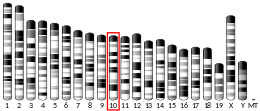STAB2
Stabilin-2 is a protein that in humans is encoded by the STAB2 gene.[5][6][7]
Function
This gene encodes a large, transmembrane receptor protein which may function in angiogenesis, lymphocyte homing, cell adhesion, or receptor scavenging. The protein contains 7 fasciclin, 15 epidermal growth factor (EGF)-like, and 2 laminin-type EGF-like domains as well as a C-type lectin-like hyaluronan-binding Link module. The protein is primarily expressed on liver sinusoidal endothelial cells, spleen, and lymph node. The receptor has been shown to bind and endocytose ligands such as hyaluronan, low density lipoprotein, Gram-positive and Gram-negative bacteria, and advanced glycosylation end products. Supporting its possible role as a scavenger receptor, the protein has been shown to cycle between the plasma membrane and lysosomes.[7]
References
- GRCh38: Ensembl release 89: ENSG00000136011 - Ensembl, May 2017
- GRCm38: Ensembl release 89: ENSMUSG00000035459 - Ensembl, May 2017
- "Human PubMed Reference:". National Center for Biotechnology Information, U.S. National Library of Medicine.
- "Mouse PubMed Reference:". National Center for Biotechnology Information, U.S. National Library of Medicine.
- Politz O, Gratchev A, McCourt PA, Schledzewski K, Guillot P, Johansson S, Svineng G, Franke P, Kannicht C, Kzhyshkowska J, Longati P, Velten FW, Johansson S, Goerdt S (February 2002). "Stabilin-1 and -2 constitute a novel family of fasciclin-like hyaluronan receptor homologues". The Biochemical Journal. 362 (Pt 1): 155–64. doi:10.1042/0264-6021:3620155. PMC 1222372. PMID 11829752.
- Adachi H, Tsujimoto M (September 2002). "FEEL-1, a novel scavenger receptor with in vitro bacteria-binding and angiogenesis-modulating activities". The Journal of Biological Chemistry. 277 (37): 34264–70. doi:10.1074/jbc.M204277200. PMID 12077138.
- "Entrez Gene: STAB2 stabilin 2".
Further reading
- Tamura Y, Adachi H, Osuga J, Ohashi K, Yahagi N, Sekiya M, Okazaki H, Tomita S, Iizuka Y, Shimano H, Nagai R, Kimura S, Tsujimoto M, Ishibashi S (April 2003). "FEEL-1 and FEEL-2 are endocytic receptors for advanced glycation end products". The Journal of Biological Chemistry. 278 (15): 12613–7. doi:10.1074/jbc.M210211200. PMID 12473645.
- Zhou B, McGary CT, Weigel JA, Saxena A, Weigel PH (May 2003). "Purification and molecular identification of the human hyaluronan receptor for endocytosis". Glycobiology. 13 (5): 339–49. doi:10.1093/glycob/cwg029. PMID 12626425.
- Smedsrød B, Johansson S, Goerdt S (May 2003). "Shooting HARE". Glycobiology. 13 (5): 11G–12G, author reply 12G. doi:10.1093/glycob/cwg072. PMID 12751488.
- Dobreva G, Dambacher J, Grosschedl R (December 2003). "SUMO modification of a novel MAR-binding protein, SATB2, modulates immunoglobulin mu gene expression". Genes & Development. 17 (24): 3048–61. doi:10.1101/gad.1153003. PMC 305257. PMID 14701874.
- Harris EN, Weigel JA, Weigel PH (August 2004). "Endocytic function, glycosaminoglycan specificity, and antibody sensitivity of the recombinant human 190-kDa hyaluronan receptor for endocytosis (HARE)". The Journal of Biological Chemistry. 279 (35): 36201–9. doi:10.1074/jbc.M405322200. PMID 15208308.
- Hansen B, Longati P, Elvevold K, Nedredal GI, Schledzewski K, Olsen R, Falkowski M, Kzhyshkowska J, Carlsson F, Johansson S, Smedsrød B, Goerdt S, Johansson S, McCourt P (February 2005). "Stabilin-1 and stabilin-2 are both directed into the early endocytic pathway in hepatic sinusoidal endothelium via interactions with clathrin/AP-2, independent of ligand binding". Experimental Cell Research. 303 (1): 160–73. doi:10.1016/j.yexcr.2004.09.017. PMID 15572036.
- Harris EN, Kyosseva SV, Weigel JA, Weigel PH (February 2007). "Expression, processing, and glycosaminoglycan binding activity of the recombinant human 315-kDa hyaluronic acid receptor for endocytosis (HARE)". The Journal of Biological Chemistry. 282 (5): 2785–97. doi:10.1074/jbc.M607787200. PMID 17145755.



